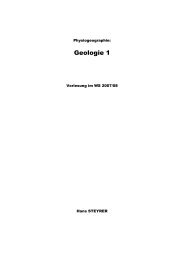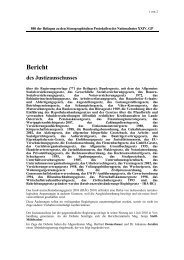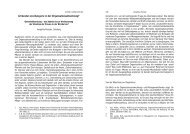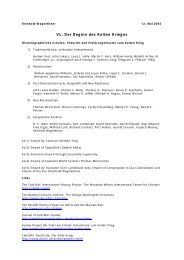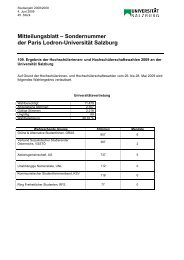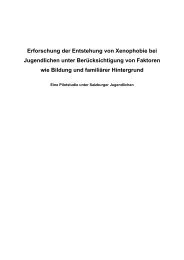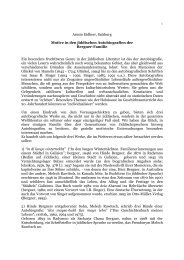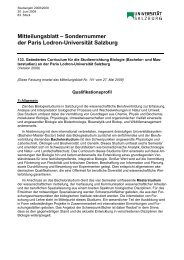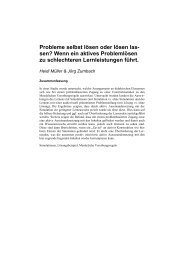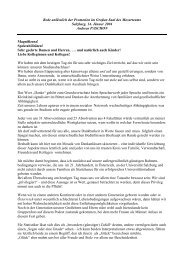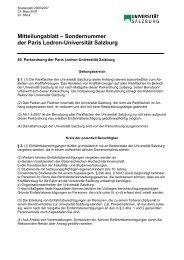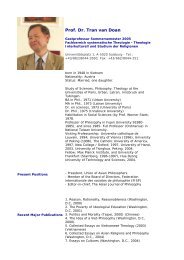Klima im Wandel Climate Change - Universität Salzburg
Klima im Wandel Climate Change - Universität Salzburg
Klima im Wandel Climate Change - Universität Salzburg
Sie wollen auch ein ePaper? Erhöhen Sie die Reichweite Ihrer Titel.
YUMPU macht aus Druck-PDFs automatisch weboptimierte ePaper, die Google liebt.
<strong>Kl<strong>im</strong>a</strong>schwankungen und -trends des älteren Holozäns<br />
in den südlichen Niederen Tauern: multidisziplinäre<br />
Auswertung eines Sed<strong>im</strong>entkerns aus dem Oberen<br />
Landschitzsee (Lungau)<br />
Schmidt R. 1) , Kamenik C. 2) , Kaiblinger C. 1) , Tessadri R. 3)<br />
1)<br />
Institut für L<strong>im</strong>nologie, Österreichische Akademie der Wissenschaften, Mondsee,<br />
Österreich,<br />
2)<br />
Oeschger Center for Cl<strong>im</strong>ate Research & Institut für Geographie, Universität Bern,<br />
Schweiz<br />
3)<br />
Institut für Mineralogie und Petrographie, Universität Innsbruck, Österreich<br />
Abstract<br />
Early-Holocene cl<strong>im</strong>ate changes and trends in the southern Niedere Tauern: a multiproxy<br />
study of a lake sed<strong>im</strong>ent core from Oberer Landschitzsee (Lungau)<br />
Lake Oberer Landschitzsee (2.067 m a.s.l.) is a key site for the reconstruction of Holocene<br />
cl<strong>im</strong>ate changes at the southern Austrian Central Alps (Niedere Tauern, Lungau). The lake<br />
is located in a cl<strong>im</strong>atically sensitive ecotone close to the alpine treeline. Its radiocarbon (AMS<br />
14<br />
C) dated sed<strong>im</strong>ents have been studied intensively using a multi-proxy approach. Local<br />
glaciers, which originated from the Younger Dryas cold period, have disappeared during the<br />
early Holocene warming. Subsequently, Oberer Landschitzsee was affected by two cold and<br />
wet periods. The first started about 10.5 kyrs before present (BP) and culminated at ca. 10.2<br />
kyrs BP. The second occurred between ca. 9.5 and 9.2 kyrs BP. From ca. 9.2 to 8.7 kyrs BP<br />
a period of lake summer warming separated these older cl<strong>im</strong>ate oscillations from younger<br />
cl<strong>im</strong>ate deteriorations between ca. 8.7 to 7.6 kyrs BP. The latter coincided with glacier advances<br />
in the nearby Hohe Tauern (Venediger, Frosnitz), whereas in the Niedere Tauern perennial<br />
snowfields developed, which kept summer lake water temperatures low. Prolonged summer<br />
warming and late autumn mixing characterized the following three warm periods (Holocene<br />
opt<strong>im</strong>um events) between ca. 7.5 to 5.3 kyrs BP, which were interrupted by two cold fluctuations.<br />
The snowfields and possibly permafrost in the catchment of the lake disappeared during<br />
the Holocene opt<strong>im</strong>um events, resulting in distinct lake warming (principle of ultra-sensitive<br />
lakes). The interval between ca. 7 and 6 kyrs was more continental than the younger one from<br />
ca. 6 to 5.3 kyrs BP. The change in continentality could explain the lowering in t<strong>im</strong>ber/treeline.<br />
During the following cl<strong>im</strong>ate oscillation at ca. 5 kyrs BP, pronounced wet and snowrich<br />
conditions altered with drier ones. The period from ca. 5 to 4 kyrs BP indicated strong<br />
seasonal divergence, most probably due to the increasing <strong>im</strong>pact of the mediterranean winterrain<br />
cl<strong>im</strong>ate on the area south of the Alps. In sum, the t<strong>im</strong>e-window from ca. 11.5 to 4 kyrs<br />
BP indicated (i) increasing temperatures with a plateau between 7.5 and 5.3 kyrs BP, (ii) a<br />
alpine space - man & environment, vol. 6: <strong>Kl<strong>im</strong>a</strong>wandel in Österreich<br />
© 2009 iup • innsbruck university press, ISBN 978-3-902571-89-2




